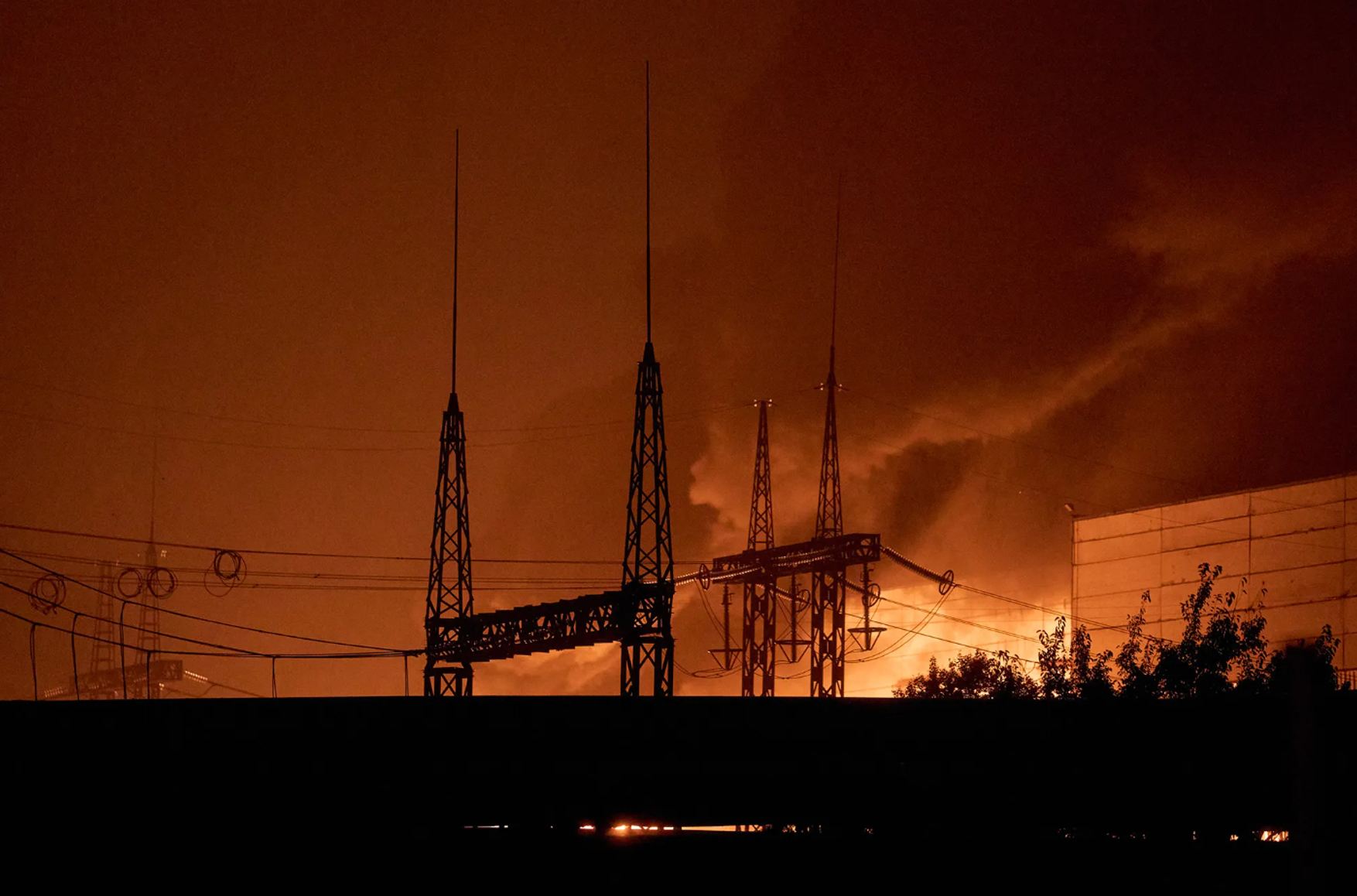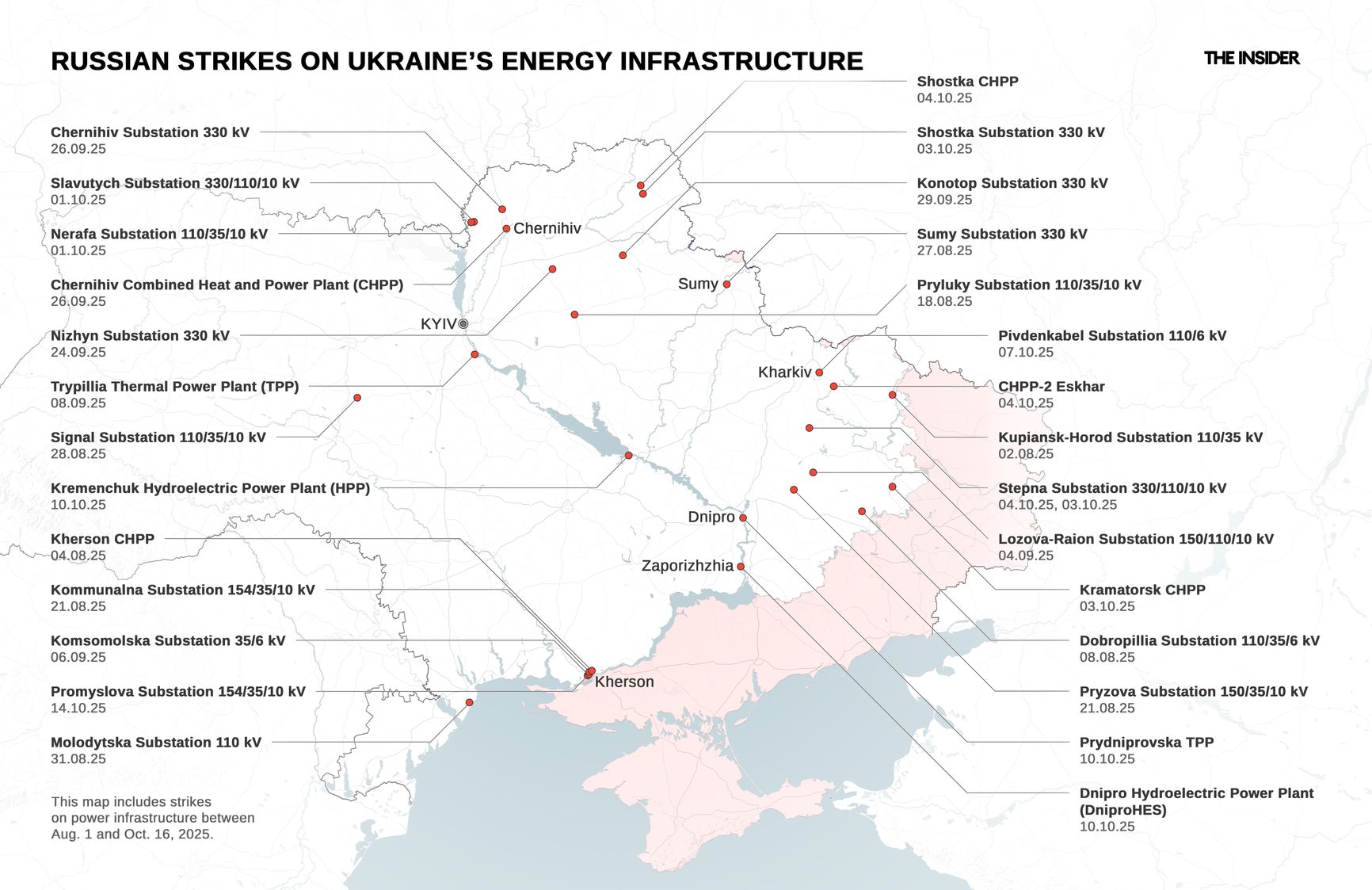
Photo: Kostiantyn Liberov / Libkos / Getty Images

Photo: Kostiantyn Liberov / Libkos / Getty Images
In the early hours of Oct. 30, 2025, a massive Russian air assault targeted four major power facilities across Ukraine — the Dobrotvir Thermal Power Plant in the Lviv Region, the Burshtyn and Kalush combined heat and power plants in the Ivano-Frankivsk Region, and the Ladyzhyn Thermal Power Plant in the Vinnytsia Region — triggering electricity shortfalls nationwide. The Kremlin has once again launched a winter campaign of strikes on Ukraine’s energy infrastructure, this time aiming to split the power grid into isolated sections and trigger a humanitarian crisis. To counter the assault, Ukraine needs to strengthen its air defenses, build protective structures, and improve the resilience of its energy system. Otherwise, it will face worsening blackouts and multibillion-dollar recovery costs. Restoring the energy system to full capacity after Russia’s attacks is expected to cost $67.8 billion over the next ten years.
Russia’s long-range strike strategy
The current wave of attacks on Ukraine’s energy sector
Blackouts are inevitable, and hot water shortages are likely
For several months, Russian forces have carried out a sustained campaign of airstrikes targeting Ukraine’s energy infrastructure. While Ukraine’s own strikes inside Russia have focused on oil refineries, gas-processing plants, petrochemical facilities, fuel depots, pipelines, and export terminals — aiming to disrupt Russia’s domestic fuel market and disrupt the oil, gas, and petroleum exports that provide most of the Kremlin’s foreign currency revenue — Moscow has made Ukrainian power plants, transformer substations, and transmission networks its primary targets.
According to leaks published in the Western media, Vladimir Putin concluded after his August meeting in Alaska with U.S. president Donald Trump that intensifying attacks on Ukraine’s critical infrastructure could help Moscow impose its own terms for a peace settlement. The current U.S. administration, Putin reportedly reasoned, is unlikely to take meaningful countermeasures. The plan has been echoed in Russian state propaganda, including in videos distributed by pro-Kremlin outlets threatening Ukrainians with a “harsh winter.”
The Alaska summit took place on Aug. 15, 2025; four of the five largest air assaults on Ukraine this year occurred in the weeks that followed. The single largest attack came on Sept. 7, 2025, when Russia launched 823 aerial weapons — 810 drones and 13 missiles. During the night of Oct. 30, 2025, another major strike hit four Ukrainian power plants simultaneously: the Dobrotvir Thermal Power Plant in the Lviv Region, the Burshtyn Thermal Power Plant and the Kalush Combined Heat and Power Plant in the Ivano-Frankivsk Region, and the Ladyzhyn Thermal Power Plant in the Vinnytsia Region. That assault involved 653 drones and 52 missiles.
Ukraine is entering its fourth winter at war — and is facing its fourth campaign of Russian strikes on critical infrastructure. Only once, in November 2022, did Moscow succeed in causing prolonged nationwide blackouts, which left millions without power for periods lasting up to days at a time.
During the winter of 2023-2024, Russia’s attacks targeted not only energy facilities but also logistics hubs, industrial sites, and port infrastructure. Catastrophic damage was averted thanks to warm weather, deliveries of Western air defense systems, and Ukraine’s integration into Europe’s power grid.
In the fall of 2024, Russia managed to disable roughly 80% of Ukraine’s power generation capacity by damaging nearly all major thermal power plants. Yet the country endured the winter without major outages. As of early 2025, direct damage to Ukraine’s energy sector was estimated at $20.5 billion, more than double the previous year’s figure, while other infrastructure sectors saw only modest increases in estimated repair costs. Overall, rebuilding Ukraine’s energy network will require outlays of at least $67.8 billion over the next ten years.
As of early 2025, direct damage to Ukraine’s energy sector was estimated at $20.5 billion.
This time, Russia’s strikes are focused less on power plants and more on the grid itself — substations and transmission lines — concentrated mainly in the eastern regions of Sumy, Chernihiv, and Kharkiv. The goal appears to be to “cut off” the east, where electricity demand is high, from the generation centers in the west. Such fragmentation would make the grid far harder to manage and cause cascading power disruptions.

The Insider identified 29 strikes on major power facilities between Aug. 1 and Oct. 16, 2025, 20 of which targeted substations. Nine of those sites transform 750 kV down to 330 kV or 110 kV. There are approximately 90 such sites nationwide, and each of them represents a critical node in Ukraine’s power grid. These facilities are easier to hit than nuclear power plants, which generate over 60% of Ukraine’s electricity but are heavily fortified from direct strikes. However, by crippling grid components and damaging thermal plants, Russia can provoke blackouts even as generation capacity remains intact. Front-line energy sites are also far more difficult to protect than those in the rear.
Russia’s strikes are focused on substations and transmission lines.
At the same time, Russia is striking gas production facilities as part of an effort to force Ukraine to import more fuel for its gas-fired plants. According to current estimates, the attacks have disrupted operations at sites providing 60% of Ukraine’s daily gas output (many of which can be restored relatively quickly).
Over nearly four years of war, Ukraine has gained extensive experience in quickly restoring critical infrastructure. The country has stockpiled fuel and spare parts, deployed mobile repair crews, and regularly conducts emergency drills. In the Kyiv and Dnipropetrovsk regions, large battery storage sites have been built to temporarily replace lost power capacity for several hours during repairs, and the number of distributed generation facilities continues to grow.
Ahead of the 2025-2026 winter, Ukraine even managed to increase its available installed power capacity, though this still amounts to just over one-third of the prewar level. The country has also significantly expanded its capacity for power exchanges with Europe and is now able to export up to 900 megawatts and import up to 2.1 gigawatts. Notably, Ukraine remained a net exporter of electricity until September 2025.
Aside from nuclear power plants, no energy facility in Ukraine can be fully protected by air defense systems. The key challenge is therefore maintaining system resilience and repairing damage as quickly as possible. However, estimates show that due to bureaucratic delays and funding shortfalls, Ukraine has still not completed construction of mandatory protective structures at key power plants and substations.
The overall effect of the Russian campaign is also contingent on the weather. Peak demand during the winter of 2023-2024 reached 18 gigawatts, while in 2024-2025 it dropped to 16.5 thanks largely to warmer temperatures. A colder winter would almost certainly push demand above 18 gigawatts again, while the Ukrainian Energy Ministry’s baseline forecast for this winter projects 17.6 gigawatts of available capacity. Under an unfavorable scenario, the deficit could reach up to 6 gigawatts.
Aside from nuclear power plants, no energy facility in Ukraine can be fully protected by air defense systems.
If Russian strikes on regional power infrastructure continue, localized blackouts spanning multiple districts — or even entire regions — are possible. Moscow’s apparent goal is to create recurring outages along Ukraine’s border and front-line areas, disrupting daily life, increasing refugee flows, and fueling political pressure on Kyiv.
Even under moderately optimistic forecasts, Ukrainian energy experts expect civilians will live by a “4×2” formula this winter — four hours without power followed by two hours with electricity. Combined heat and power plants may also struggle to provide heating and hot water, for which there are no simple backup or redistribution options.
However, this winter the Ukrainian military may attempt to respond in kind. Since mid-October, Ukrainian strikes inside Russia and the occupied territories have hit at least 15 energy facilities, including thermal power plants and substations, in regions as far from the front lines as Vladimir, Nizhny Novgorod, and Ulyanovsk. In late September and early October, sustained blackouts were reported in Russia’s Belgorod Region following Ukrainian attacks on energy infrastructure.
К сожалению, браузер, которым вы пользуйтесь, устарел и не позволяет корректно отображать сайт. Пожалуйста, установите любой из современных браузеров, например:
Google Chrome Firefox Safari